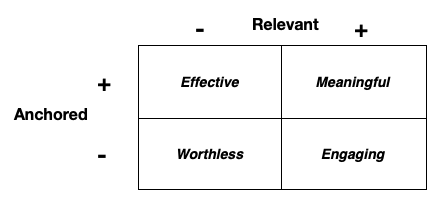In reviewing my forthcoming book on Make It Meaningful, I’m poring over my Education -Engagment Alignment (EEA). I’m rewriting part to revisit it. Which I’ve done, but in doing so I had a revelation. I’ve maintained that they’re independent elements. However, I now see Relevant and Anchored as complementary components.
‘Anchored’, in my terminology, is ensuring the learning outcome meets a real need. It’s about the relationship between the learning objective and the performance gap. If you’re trying to get better at something, for instance, the objective is specifically related. If you’re learning about dealing with customer objections, you’ve got a specific objective to use a particular approach. It is not ‘understand’ but ‘do’. You’re not anchoring if your root cause of the performance gap isn’t a lack of skill. If the learning covers information that’s ‘nice to know’, you’re not anchored. This is determined, by the way, by a performance consulting process.
‘Relevant’, again the way I term it, is about whether the learner cares about that learning objective. If learners don’t care about being a repair tech, having an objective about the problem-solving process can’t matter. This is something we should design into the experience. That is, we should be helping learners ‘get’ that the consequences of acquiring this skill matter to them. We can use curiosity, or consequences, or…but we should not leave it to chance!
Using the usual present/absent two-factor diagram, it looks like this:
That is, if you have neither the effort is worthless. Which is like a lot of what we see! When you’re anchoring, but not being relevant, the solution is likely to be moderately effective (tho’ not as much as it could be). People stay away if possible! If it’s relevant but not anchored, it’ll be engaging, but not effective and not meaningful. This is the typical tarted up stuff, aka well-produced but not well-designed and produced. However, if you get both in there, you’ve truly made it meaningful.
I suggest you want relevant and anchored. If we’re putting in the effort, we should be aligning both. I suggest LXD means the elegant integration of learning science with engagement. It sticks better! We know how to do this, reliably and repeatedly. Our learning doesn’t have to be dull nor ineffective, and we owe our learners this.
I am co-authoring a book on how to improve the effectiveness of leadership development in organizations. Although we hadn’t thought of the words “Anchored” and “Relevant” that is exactly the concept we are advocating if the training is to succeed. As you may know, organizations in the USA spend over $100 billion annually for leadership development events that are dismally ineffective according to the research. Our own analysis is the ineffectiveness is due to these so-called training events being disengaging and meaningless. I look forward to reading your book.
Thanks for the comment. I’ll add (“yes, and…” :) that I think many other training initiatives, F2F and elearning, are so undermined. Similarly, agree that leadership development is a racket (c.f. Pfeffer’s Leadership BS). Cheers if you’re doing something more meaningful!
Hi Clark!
I’m currently an instructional design student and am enjoying using your blog as a complement to the weekly materials in my current course (Learning Theories and Instruction). This post ties in nicely this week with what we’ve learned about working memory (WM) and long-term memory (LTM). I’m actually using this as part of an assignment.
In a two-store dual memory model, information processing begins with stimulus input (Ormrod et. al, 2009). There is so many stimuli in today’s world that it’s hard to compete for attention. Your concept of anchored and relevant components of learning help ensure that the stimuli we are presenting in that moment has a higher chance of being committed to long-term memory.
Being anchored and relevant aids in information processing. The first step is encoding, or deciding what the problem is about (Laureate Education, n.d.). When presented with information that has nothing to do with you or your work, it’s harder to process what the problem is. Retrieval, the next step, is recalling information that relates to the problem – exactly what you are talking about by being anchored and relevant. I also believe that being anchored and relevant assists with the final step of information processing and problem solving – metacognition (Laureate Education, n.d.). It’s important to be able to reinforce our learning by being able to ask questions like “can I apply this?†and “what can I do with this?â€
Thank you for sharing your insight and knowledge. I look forward to reading more of your work!
References
Laureate Education (Producer). (n.d.). Information processing and problem solving [Video file]. Baltimore, MD: Dr. Jean Ormrod.
Ormrod, J., Schunk, D., & Gredler, M. (2009). Learning theories and instruction (Laureate custom edition). New York, NY: Pearson.